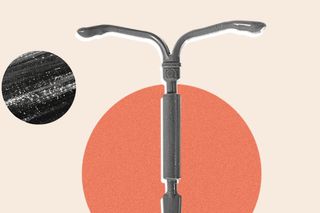
All You Need To Know About IUDs
IUDs are known to be among the most effective, reversible, long-term methods of birth control.

An intrauterine device, or IUD, is a small, T-shaped contraceptive device slightly larger than a rupee coin. Made of copper or plastic, IUDs inserted into the uterus are among the most effective, reversible, and long-term methods of birth control.
While they are an excellent contraceptive, IUDs don’t prevent sexually transmitted infections, leading experts to recommend the use of condoms alongside IUDs.
How do IUDs work?
IUDs prevent pregnancy by blocking the progress of sperm cells in the uterus, thus ensuring they don’t reach and fertilize the egg. IUDs generally start working as a contraceptive immediately following insertion.
How do you get an IUD?
IUDs are inserted by clinicians through a simple Pap smear-like procedure, which may be entirely painless for some, cause mild discomfort for a few, and cause pain, bleeding, and even dizziness for others. These potential side effects of the procedure go away in a few days and can be mitigated with medicines.
Who can get IUDs?
Any non-pregnant individual with a uterus can have an IUD inserted as a birth control mechanism, including younger individuals and/or those who have never been pregnant. For people who have given birth, IUDs may be inserted six weeks after childbirth at the soonest.
Sometimes, the size or shape of one’s uterus may make it difficult to insert or situate an IUD.
Experts suggest that IUDs may not, however, be advisable for pregnant people or people with existing health problems. For instance, an IUD of any kind is not recommended for anyone suffering from a pelvic or sexually transmitted infection or cancer of the cervix or the uterus. Moreover, copper IUDs are not recommended for those with a copper allergy or Wilson’s disease, which causes a build-up of copper in the body. Similarly, hormonal IUDs may be unsafe for people with liver diseases or breast cancer.
Related on The Swaddle:
Survey Shows Most Indians Are Confused About Contraception. Are You One of Them?
What are the different types of IUDs?
Copper IUDs: Also known as the copper-T, this IUD releases copper ions into the uterus, which work as a spermicide and thus preventing fertilization. Even if fertilization does happen, the copper-T makes the uterus hostile to implantation.
Copper IUDs can also be used for emergency contraception; they are 99.9% effective at preventing pregnancy if inserted within five days of unprotected intercourse. These IUDs are the “most effective way to prevent pregnancy after sex,” according to Planned Parenthood. Overall, copper IUDs have a failure rate of 0.8%, and they can last for up to 10-12 years after insertion.
Hormonal IUDs: Hormonal IUDs release a form of the hormone progestin, which thickens the cervical mucus, making it impossible for sperm cells to reach the egg. They also cause the lining on the inside of the uterus to thin, preventing implantation of a fertilized egg, just like their copper counterparts. Additionally, some hormonal IUDs may also prevent the release of eggs from the ovaries — nipping off the risk of pregnancy at the bud. The failure rate for hormonal IUDs is 0.2%, and they can last between three to five years, depending on the kind of hormonal IUD and its dosage.
Related on The Swaddle:
Period Tracking Apps Are a Contraceptive Gift to a Tech‑Savvy Woman… Or Are They?
What are the advantages of using IUDs?
- They do not interrupt one’s sex life and don’t require any form of preparation before intercourse.
- They can be cost-effective in the sense that there are no additional costs beyond that of insertion.
- They are safe to use while breastfeeding.
- They are a completely reversible method of birth control, and it is possible to get pregnant as soon as the device is removed.
- Some hormonal IUDs may also relieve menstrual pain, heavy flow during periods, and pain from endometriosis.
Are are any disadvantages or risks associated with using IUDs?
- Unlike hormonal IUDs, copper-Ts can make periods heavier and worsen menstrual cramps.
- Hormonal IUDs can make periods irregular.
- IUD insertion increases the risk of pelvic inflammatory disease, especially within the first 21 days after insertion.
- IUDs can cause ovarian cysts, but they’re generally asymptomatic, harmless, and go away within three months. However, rarely these cysts cause bloating or pain, especially if they rupture.
- IUDs don’t protect against sexually transmitted diseases, making it necessary to use condoms during sex.
- In the rare instance of IUD failure, there is a higher risk of ectopic pregnancy.
Devrupa Rakshit is an Associate Editor at The Swaddle. She is a lawyer by education, a poet by accident, a painter by shaukh, and autistic by birth. You can find her on Instagram @devruparakshit.
Related


Public Complacency, Not Covid19 Mutation, Is Driving the Surge in Cases, Health Experts Say
